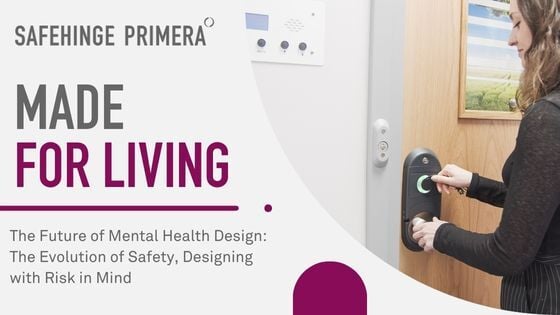What reliable anti-barricade stops mean in a real ward environment
Imagine a ward, mid-afternoon
A nurse approaches a patient’s room after hearing repeated loud and echoing bangs. The patient inside is distressed, slamming the door again and again.
When the noise finally stops, the nurse checks on the service user, and then proceeds to test the hinged anti-barricade stop, but it has been damaged and stopped working.
In that moment, everything else disappears. Safety, routine, dignity, all paused because one small, but critical for safety, component has given way. A bedroom without a functioning barricade system isn’t safe.
Across mental health environments, this is not a rare event. For staff and estate teams it is a consistent and frequently recurring frustration: anti-barricade stops that jam or break. Each time they do, the consequences ripple through the ward. Rooms are closed, patients relocated, the unplanned work loaded onto stretched estates teams, contractors called, dust and disruption follow. And everyone is left asking the same question:
How did something designed for safety become a constant source of risk, disruption and cost?
The everyday reality behind reliability
For years, the industry has treated anti-barricade reliability as a “rare-event” issue. Something you only notice in a crisis. But talk to staff on the ground and a different story emerges.
Push-button stops, often installed above doorframes, are used multiple times each month on many wards. Every time a clinician presses one, they put their fingers and body in harm’s way, standing in front of a door that can be swung as a weapon by people in distress. While hinge-mounted systems were meant to solve the robustness issues of push-button stops, they’ve improved, but haven’t resolved the key issues of robustness and staff safety.

When a door is slammed repeatedly, as often happens in high-stress environments, hinged stops can bend, warp, or fail entirely. The device might only cost a few hundred pounds to replace, but by the time estates teams have surveyed, ordered parts, and brought contractors on site, the cost in disruption and care continuity is far higher.
One damaged stop can take a bedroom out of service for days, forcing staff to decant a patient, find temporary capacity – with the costs associated, and manage the knock-on effects across an overstretched ward.


These failures do not just drain maintenance and operational budgets; they drain confidence. Ward managers know that when a stop fails once due to service user damage, replacing with the same product, it’s only a matter of time for the disruption to repeat. The same weak point, the same cycle of frustration.
“We kept replacing damaged hinged-stop doorsets like-for-like, knowing it was only a matter of time before the next repair or replacement. It cost us money and confidence. Since switching to Safehinge Primera doorsets in 2018, we haven’t had to worry about door damage anymore.”
Philip Bytheway, Director of Estates and Facilities, Priory Group
The hidden cost of a single failure
Take an 80-bed mental health facility. If just two barricade stops fail each month, that’s two bedrooms suddenly out of action. Two private spaces no longer available when they’re needed most.
Each one costing around £500 in replacement parts, that’s £1,000 per month, £12,000 per year. But the real cost and disruption reaches far beyond the broken part.
Each failure triggers a ripple effect. A patient has to be moved, sometimes more than once at additional costs. Ward staff scramble to reshuffle rooms, update care plans, and keep routines steady. Estates teams coordinate inspections, safety checks, and urgent repairs. Contractors are called in, corridors are closed off, and the normal rhythm of the ward falters.
What begins as one small mechanical failure quickly becomes a human one, a loss of calm, continuity, and trust.
How much could your organisation save? Use our quick calculator here.
Disruption and resource impact (anecdotal):
|
Metric |
Per Failure |
Annual Estimate (80-bed facility) |
Impact |
|
Frequency of failure |
2 per month |
24 per year |
Typical rate observed in active mental health wards |
|
Bedroom unavailable |
5 days |
120 bed-days lost |
Average time to assess, order, and replace components |
|
Patients relocated |
1–2 |
~30–40 per year |
Temporary moves disrupt continuity of care and increase distress |
|
People involved per incident |
5 |
— |
Estates, contractor, clinical, H&S, admin |
|
Coordination time |
5 days |
— |
Cross-departmental effort to manage safety checks and repairs |
|
Person-days per failure |
~10 |
~240 per year |
5 people × 2 days active involvement per incident |
|
Equivalent full-time roles diverted |
— |
~2.6 FTE |
Based on 230 workdays per year; time spent on reactive recovery instead of proactive safety planning |
|
Impact on ward environment |
— |
Continuous |
Increased staff stress, disrupted therapeutic rhythm, heightened patient anxiety |
|
Human impact |
— |
Cumulative |
Erodes trust and stability; shifts focus from recovery to crisis management |
A hidden safety risk in plain sight
When a barricade stop is broken, it becomes a maintenance issue as well as a safety gap. Staff might not be able to enter a room in an emergency, and that delay can mean the difference between survival and tragedy.
The biggest risks, though, often appear long before any emergency. A failed stop interrupts therapeutic routines. It forces clinicians to focus on logistics, not care. It displaces patients already under stress. It brings noise, tools, and strangers into a space that should feel calm and restorative.
Every layer of disruption adds friction to already fragile relationships of trust. What looks like a hardware failure is, in truth, a chain reaction that undermines the safety and dignity of the whole ward environment.
Why reliability matters more than ever
At Safehinge Primera, we have always believed that reliability is about more than mechanical endurance. It is about creating the right conditions for care.
When every door on a ward works as intended, day after day, it frees staff to focus on what they are there to do: support people through vulnerable times.
Our approach to anti-barricade design began by asking a simple question:
What if the stop never failed?
What if it could withstand the realities of a mental health ward, the constant use, the impacts, the unpredictability, and keep working, reliably and consistently, without adding risk or downtime?
That question led to a reimagining of design. Our steel-frame based collapsible stop replaces softer materials like timber and aluminium with reinforced components and multiple locking points to distribute force evenly across the frame. It is robust, reliable, and built for everyday life on the ward.

The Priory adopted SHP’s anti-barricade doors in 2018. Since then, with many doors in operation across ~23 sites, they’ve never experienced a single anti-barricade stop damaged by a service user, in distress or otherwise. This seven-year record reflects both the stability and durability of SHP’s Swiftstop design and the trust Priory places in proven, safety-led innovation.
“The difference is clear: safer environments, significant lower maintenance costs, and fewer disruptions to care.”
Philip Bytheway, Director of Estates and Facilities, Priory Group
Building on this success, the Priory wanted to extend the same level of reliability across its wider estate. To do so, they needed a way to manage two barricade systems on the same ward during phased upgrades, allowing older anti-barricade doors to be replaced over time as they fail.
In partnership with Priory and other NHS teams across the UK, we co-designed a multi-system key that combines both a square or oval drive and our Lifeline anti-tamper key. This simple but powerful tool gives staff safe, universal access across both systems, enabling a safe, managed transition to SHP’s proven solution.
The result is greater operational flexibility and the freedom to upgrade doors at their own pace, without added complexity, disruption, or the replacement challenges that once made resolving the robustness issues of hinged-stops difficult.

Safehinge Primera Multi Key Solution
The real measure of reliability
In mental healthcare, reliability is not proven in a test rig but in the lived reality of care. It is a nurse reaching a patient in seconds, not minutes in an emergency. It is a ward manager knowing every door will open when needed. It is an estates team freed from weekends spent arranging avoidable repairs.
Beyond the expense, it was the loss of confidence that hurt most. Replacing like-for-like only meant waiting for the next failure.
When anti-barricade stops stay strong, rooms stay open, care routines stay steady, and patients remain in familiar spaces. These small, dependable details form the foundation of safety and recovery journeys.
Imagine it never failed
Imagine a ward where staff never have to second-guess a door. Where robustness is assured. Where the quiet, unseen parts of the environment work so well that care can flow without interruption.
Albert Einstein sums it up nicely: “‘If you always do what you always did, you will always get what you always got.”
We design solutions that remove obstacles, restore confidence, and support recovery without distraction.
Want to see the new dual key in action, get in touch for a demo.
You can also access our Anti-Barricade webinar round table HERE.




